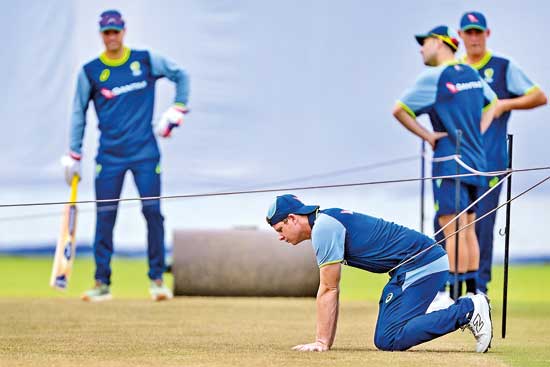Is Galle Sri Lanka’s Test stronghold any more after recent breaches?
For decades, the Galle International Stadium was Sri Lanka’s untouchable fortress in Tests, a venue where world-class spinners spun webs around opposition batsmen. But today, it stands exposed—a crumbling stronghold where foreign teams arrive with a plan, execute it with precision, and leave victorious. Once a source of pride, Galle has now become a stark reminder of Sri Lanka’s stagnation in Test cricket.
Nestled against the historic Galle Fort and the Indian Ocean, the stadium has historically been a symbol of Sri Lanka’s spin supremacy. Sri Lanka have won 19 of 33 games played, with eight loses and six draws before they entered the current decade.

Sri Lanka's Test stronghold at Galle has been breached clinically by the visiting sides in the recent times - AFP
However, in recent years—particularly in the post-pandemic era—this once-formidable stronghold has been breached with alarming regularity, turning into a hunting ground for visiting teams.
The continued reliance on Galle wasn’t purely a cricketing decision. The logistical advantages—controlled bio-bubble conditions, proximity to top-class hotels, and ease of implementing health protocols—made it the most practical choice for Sri Lanka Cricket (SLC) host their matches at Galle. Even after restrictions eased, SLC continued to favour Galle, banking on its reputation as a spin-friendly track that should, theoretically, provide the home team with an advantage.
But instead of being a safe haven, Galle has turned into a predictable trap—one where opposition teams, well-prepared and unfazed, have outmanoeuvered Sri Lanka in their own den. (Hosts have managed just eight wins out of the 15 matches they played in the post pandemic era. They have lost seven matches including their latest 2-0 annihilation against Australia–an indication of Sri Lanka’s struggle at this famous Test venue.)
The pitch at Galle has always been a haven for spinners, offering significant turn as the game progress giving crucial advantage to the home spinners. Muttiah Muralitharan, Rangana Herath, Dilruwan Perera, and more recently, Prabath Jayasuriya, have made merry on these surfaces, dismantling opposition batting lineups with ease.
Jayasuriya has been the latest beneficiary, claiming 80 of his 116 Test wickets at Galle. But does excelling on a tailor-made track truly develop an all-terrain bowler? The answer is clear—it does not. Outside Galle, Jayasuriya’s effectiveness dwindles, raising serious questions about Sri Lanka’s broader strategy.
The latest series against Australia laid bare Sri Lanka’s flaws. Despite fielding three specialist spinners in both Tests, Sri Lanka’s attack was systematically dismantled by Australian batsmen, who racked up five centuries, including a double ton. In contrast, Sri Lanka’s own batsmen—playing in their backyard—failed to register even a single century. Worse still, while Sri Lanka’s spinners managed just 17 wickets across both matches, Australia’s spinners ruthlessly exposed the home team’s batting vulnerabilities, bagging 34 of the 40 available wickets. If there was ever a moment to rethink the blind reliance on Galle, this was it.
“I think we should play on better wickets,” voiced Sri Lanka skipper Dhananjaya de Silva, after overseeing Sri Lanka’s heartbreaking capitulation.
“If you look out our averages are much lower than other players and the reason is we play our cricket mostly on spinning tracks. We should play on good wickets and this will help bowlers improve their skills. I think going forward, we need to rethink our strategy and play on sporting wickets”.
While Sri Lanka have beaten teams like West Indies, Ireland and New Zealand at Galle, teams like Australia, England and Pakistan have shown remarkable adaptation to the conditions and have beaten the hosts with ease. Sri Lanka’s strategy at Galle has been predictable—produce a raging turner and rely on spinners to do the damage. While this approach worked in the past against lowly ranked team, top opposition teams have adapted and countered well. England’s aggressive sweeping, Australia’s disciplined batting, and Pakistan’s patient approach have all nullified Sri Lanka’s primary weapon. Moreover, Sri Lanka’s spinners, while talented, have not been as potent as the legendary Muralitharan or Herath, leading to diminishing returns.
The absence of a formidable fast-bowling attack has been another critical issue. While teams like Australia, England and Pakistan have used fast bowlers effectively to extract reverse swing and break partnerships, Sri Lanka’s over-reliance on spin has made them one-dimensional. Without a pace-bowling threat, opposition teams have been able to construct big totals and revert the pressure back on Sri Lanka.
The batting unit has been equally abysmal. The very conditions designed to help Sri Lanka’s spinners have also crippled their batsmen, who struggle against quality opposition on challenging surfaces. Frequent collapses, an inability to bat time, and poor shot selection have compounded the team’s woes. If Sri Lanka cannot even play spin effectively at home, how can they expect to handle it overseas?
The solution is obvious yet long overdue: move away from the Galle-centric approach and embrace sporting wickets elsewhere. Sri Lanka must develop a well-rounded attack that includes fast bowlers capable of exploiting reverse swing. Equally important, their batsmen must evolve—learning to counter both spin and pace with resilience and adaptability. If not, Galle will remain nothing more than a deceptive relic of past glories—an illusion of home dominance that crumbles the moment real competition arrives.
Sri Lanka’s next challenge is against Bangladesh in June. The question is: will Sri Lanka Cricket continue down the same flawed path, or will they finally break free from the Galle trap and build a future that isn’t just reliant on spin-friendly pitches?


